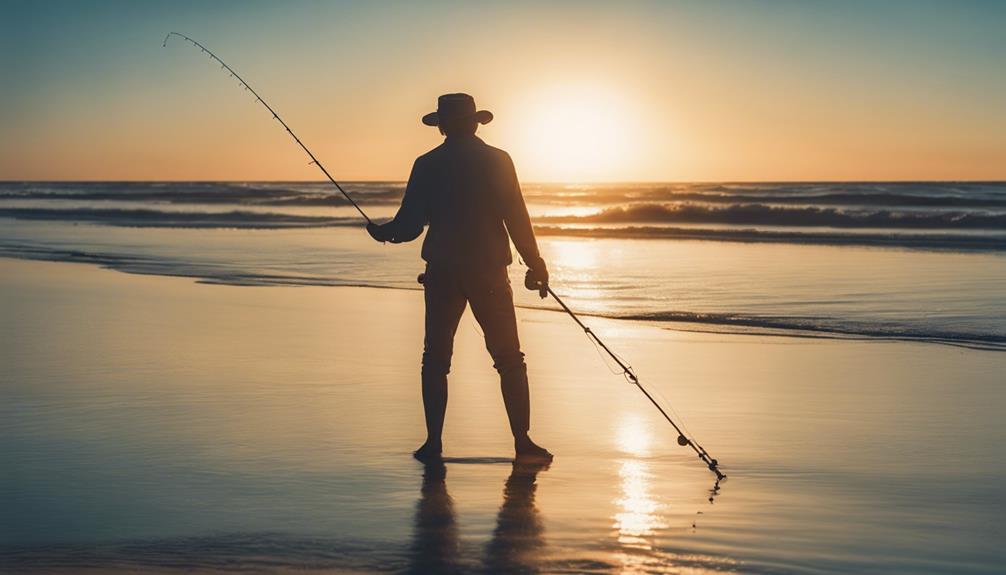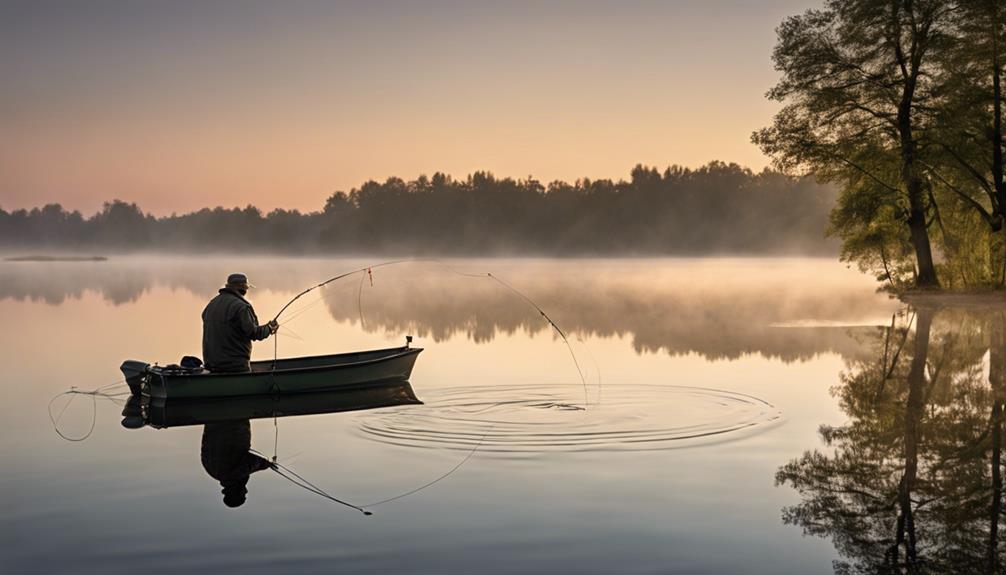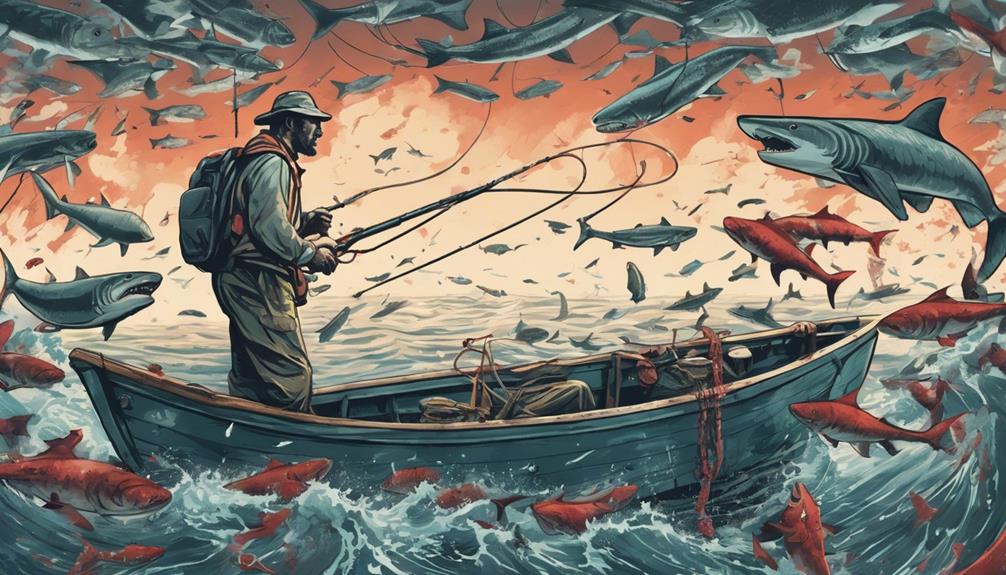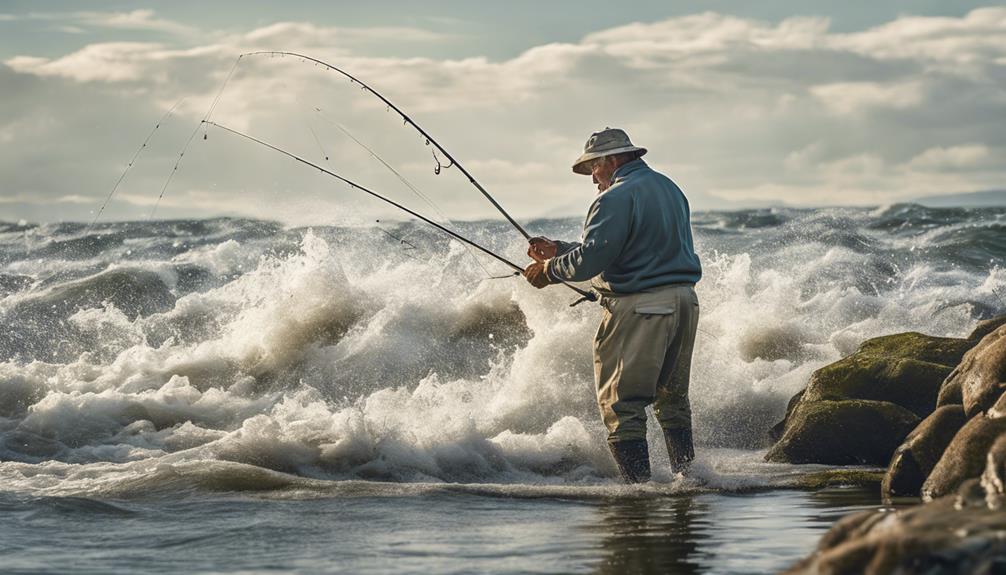When embarking on your saltwater fishing journey, mastering basic casting techniques is crucial for success. Imagine standing on a picturesque pier, surrounded by the vast ocean, ready to cast your line.
As you prepare to make that first throw, the technique you use can make all the difference in the world. But what exactly goes into perfecting your casting skills?
Stay tuned to discover the fundamental steps that will set you on the path to becoming a proficient saltwater angler.
Selecting the Right Gear
When gearing up for saltwater fishing, ensure you select the right equipment tailored to the specific type of fish you aim to catch. Proper gear maintenance and storage are essential for preserving your equipment and ensuring it remains in top condition for your next fishing trip. After each fishing excursion, make it a habit to clean your gear thoroughly with fresh water to remove any salt residue that can cause corrosion. Check for any signs of wear and tear on your reels, rods, and lines, and address any issues promptly to prevent further damage.
Tackle organization plays a crucial role in efficient fishing. Arrange your tackle box logically, grouping similar items together for easy access. This not only saves time on the water but also helps you keep track of your gear. Invest in tackle trays or boxes with dividers to prevent items from getting tangled or damaged during transportation. Proper equipment care extends the lifespan of your gear, saving you money in the long run. Store your gear in a cool, dry place away from direct sunlight to prevent warping or weakening of materials due to heat exposure.
Understanding Tides and Currents
To improve your success in saltwater fishing, understanding tides and currents is crucial for strategically positioning yourself to catch more fish. Tides are the rise and fall of sea levels caused by the gravitational forces of the moon and the sun. These tidal movements influence the behavior and location of fish, making it essential to adjust your fishing strategies accordingly. When the tide is high, fish tend to move closer to shore, while during low tide, they may be found in deeper waters.
Currents, on the other hand, are the continuous flow of water in a particular direction. They can affect how your bait or lure moves in the water, impacting the way fish perceive and react to it. By understanding the direction and strength of currents in your fishing area, you can adapt your techniques to present your bait more naturally to the fish.
Weather patterns also play a significant role in the movement of tides and currents. Wind direction, atmospheric pressure, and temperature changes can influence the intensity of tides and the speed of currents. Keeping an eye on weather forecasts can help you anticipate these changes and adjust your fishing approach accordingly, increasing your chances of a successful catch. By mastering the dynamics of tides, currents, and weather, you can become a more skilled and efficient saltwater angler.
Mastering Basic Casting Techniques
Improving your saltwater fishing skills starts with mastering basic casting techniques. To become a proficient angler, focus on honing your casting abilities to ensure you can effectively place your bait or lure where the fish are. Here are three key elements to consider:
- Distance accuracy: One crucial aspect of casting is being able to accurately judge and control the distance your lure travels. Practice different casting techniques to improve your accuracy at various distances. Remember, different fish species may be at different distances from shore, so being able to cast with precision can greatly increase your chances of a successful catch.
- Line control: Another essential skill is mastering line control. This involves managing the tension in your line during the cast, ensuring it flows smoothly off the reel without tangling or forming knots. Proper line control not only helps you cast further but also allows you to feel even the slightest nibbles from fish once your bait is in the water.
- Technique refinement: Work on refining your overall casting technique by practicing regularly. Experiment with different rods, reels, and lures to find what works best for you. Adjust your casting angle, power, and timing to adapt to different fishing scenarios, such as casting into the wind or around obstacles. By consistently practicing and refining your technique, you'll become a more skilled angler ready to tackle various saltwater fishing challenges.
Identifying Common Saltwater Fish Species
Start by familiarizing yourself with the common saltwater fish species you're likely to encounter on your fishing excursions. Proper fish identification techniques are essential not only for your fishing success but also for conservation efforts. By being able to identify different species, you can ensure you're following regulations and practicing responsible fishing.
Each saltwater fish species has its own unique characteristics, behaviors, and habitat preferences. For example, understanding that snook are often found near mangroves and are more active during dawn and dusk can help you target them more effectively. On the other hand, species like redfish prefer shallow waters with sandy or muddy bottoms.
Conservation efforts often rely on anglers being able to accurately identify fish species. By understanding the specific features of each fish, such as the distinct spot patterns on speckled trout or the shape of a flounder, you can contribute to the protection of these populations.
Take the time to study common saltwater fish species in your area. Look into species-specific behavior and habitat preferences to enhance your fishing experience while also playing a role in marine conservation.
Learning Knot Tying Skills
Begin honing your saltwater fishing expertise by mastering essential knot tying skills. Whether you're a novice angler or a seasoned fisherman, having the ability to tie strong and reliable knots is crucial for success in saltwater fishing.
Here are three key aspects to focus on when learning knot tying skills:
- Rope Manipulation Techniques: Understanding how to manipulate the fishing line with precision is fundamental. Practice sessions where you work on techniques like loop creation, twists, and wraps will help you become proficient in handling the rope effectively. These skills are essential for tying knots that won't slip or break when reeling in a big catch.
- Fishing Line Connections: Learning various knots for connecting different parts of your fishing setup is vital. From attaching the hook to the line to joining leader lines, each connection requires a specific type of knot. Engaging in knot tying competitions can be a fun way to challenge yourself and improve your speed and accuracy in tying knots under pressure.
- Practice Sessions: Consistent practice is the key to mastering knot tying skills. Set aside time before your fishing trips to practice tying knots repeatedly. The more you practice, the more confident and efficient you'll become at tying knots quickly and securely while out on the water.
Practicing Patience and Persistence
To excel in saltwater fishing, cultivating patience and persistence is essential for navigating the challenges of the sport and achieving success. Saltwater fishing requires a calm and focused mindset, which can be achieved through mindful meditation. Before heading out, take a few moments to center yourself, clear your thoughts, and focus on the present. This practice can help you stay patient during slow fishing periods and remain persistent in your pursuit of a catch.
Effective time management is also crucial in saltwater fishing. Plan your trips wisely, taking into account factors like weather conditions, tide patterns, and fish behavior. By organizing your time efficiently, you can maximize your fishing opportunities and increase your chances of success. Remember that patience isn't just about waiting for a bite; it's also about being patient with yourself as you learn and improve your skills.
Persistence is key in saltwater fishing, as not every trip will result in a big catch. Stay dedicated to honing your abilities, trying new techniques, and exploring different fishing spots.
Exploring Different Bait and Lure Options
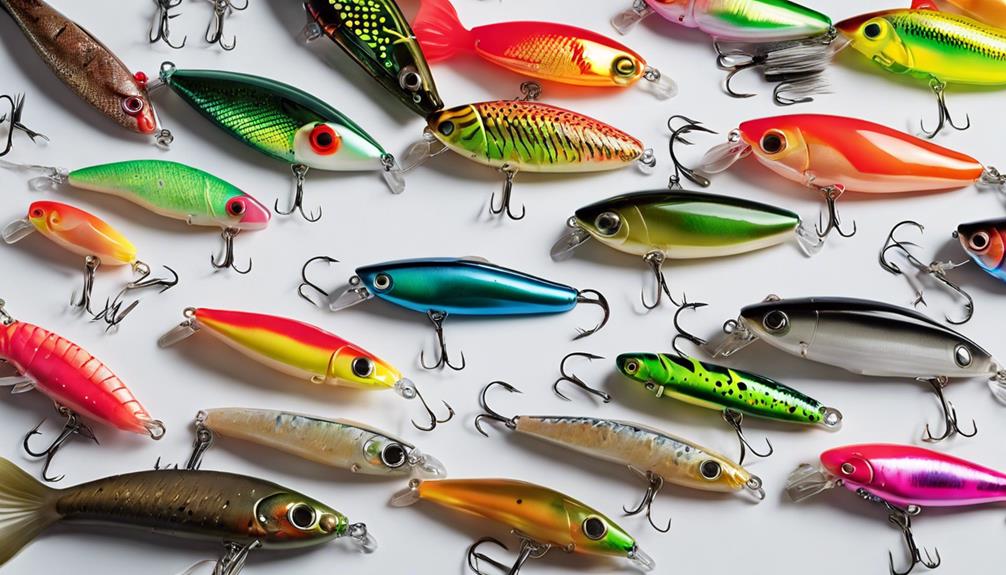
What're some effective ways to broaden your saltwater fishing skills by exploring different bait and lure options? When it comes to saltwater fishing, choosing the right bait and lures can make a significant difference in your success rate. By experimenting with various options, you can learn what works best in different conditions and for different types of fish.
- Live bait vs. artificial lures: Live bait can be more appealing to certain saltwater species due to its natural movement and scent. It can attract predatory fish effectively. On the other hand, artificial lures come in a wide range of shapes, sizes, and colors, allowing you to mimic different types of prey. They're reusable and can be less messy than live bait.
- Topwater vs. deep diving baits: Topwater baits are designed to float on the surface of the water, creating splashes and ripples that can attract fish looking to feed near the top. They're great for species like tarpon and sea trout. Deep diving baits, on the other hand, sink below the surface and are effective for targeting fish that dwell in deeper waters, such as groupers and snappers. Experimenting with both types can help you cover different depths and fishing scenarios effectively.
Safety Tips for Saltwater Fishing
Considering the importance of your well-being while engaged in saltwater fishing, understanding and implementing safety tips is crucial to enjoying a successful and secure fishing experience. Proper hydration is vital when out at sea; remember to drink plenty of water to prevent dehydration, especially under the sun's intense heat. Don't forget to apply sunscreen generously to shield your skin from harmful UV rays.
Emergency preparedness is key for any fishing trip. Ensure you have essential items like a first aid kit, a flashlight, and a fully charged phone in case of emergencies. Familiarize yourself with basic first aid procedures to handle minor injuries promptly. It's also wise to inform someone on land about your fishing plans and expected return time.
When on a boat, always wear a properly fitted life jacket. Accidents can happen unexpectedly, and a life jacket can be a lifesaver in case you fall overboard. Additionally, follow all safety instructions provided by the boat operator and pay attention to weather forecasts to avoid getting caught in dangerous conditions.
Frequently Asked Questions
How Can I Best Prepare for a Full Day of Saltwater Fishing?
To prepare for a full day of saltwater fishing, it's crucial to stay hydrated and pack snacks to keep your energy up. Remember to protect yourself from the sun with sunscreen and proper clothing.
Make sure your gear is in top shape by checking for any wear or tear. By taking care of yourself and your equipment, you'll be ready for a successful day out on the water.
What Are Some Common Mistakes Beginners Make When Saltwater Fishing?
When saltwater fishing as a beginner, it's common to make mistakes. Proper baiting techniques and avoiding tangled lines are key. Understanding tides is crucial for success.
Remember, patience and persistence pay off. Don't rush; take your time to learn and improve. Stay focused on your goals and keep practicing.
With time and effort, you'll become a skilled saltwater angler.
Are There Any Specific Regulations I Need to Be Aware of When Saltwater Fishing?
When saltwater fishing, you should be aware of specific regulations. Permit requirements ensure you're legally fishing in the area.
Size limits help conserve fish populations by allowing them to reach maturity before being caught.
Conservation efforts like catch quotas aim to maintain a sustainable marine environment.
Knowing and following these rules not only keeps you within the law but also contributes to the protection of marine life for future generations to enjoy.
How Can I Locate the Best Fishing Spots in My Area?
To locate the best fishing spots in your area, consider fishing techniques and equipment selection. Research tides and currents, as they influence where fish congregate.
Use local fishing reports, online forums, and even ask fellow anglers for advice. Explore different spots at various times to find where the fish are biting. Experiment with bait and lures to see what works best in each location.
Enjoy the thrill of discovering your go-to fishing spot!
What Are Some Tips for Properly Handling and Releasing Fish After Catching Them?
When handling and releasing fish, it's crucial to follow proper techniques for their well-being. Ethical practices include minimizing handling time, keeping fish in the water as much as possible, using wet hands or gloves, and supporting their body correctly. Avoid removing protective slime, and if needed, use tools like dehookers.
Conclusion
Now that you have mastered the basic techniques for saltwater fishing, remember to always stay safe and have patience.
Keep exploring different gear, bait, and lure options to improve your skills and increase your chances of a successful catch.
With practice and persistence, you'll become a skilled saltwater angler in no time.
So grab your gear, head out to the water, and enjoy the thrill of saltwater fishing!
